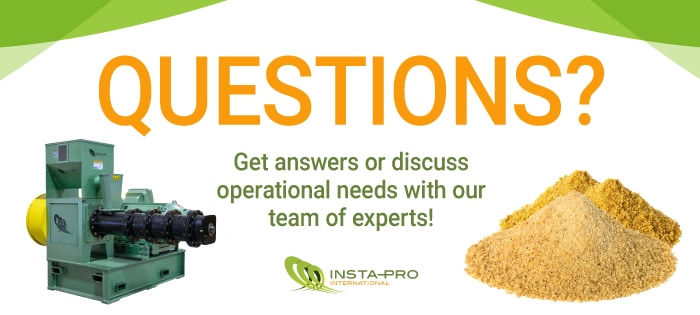Важность хорошей работы операторов на производственной линии: часть 2

altсоевые бобы, жмых, масло004alt
В предыдущей статье я обсуждал, как операторы играют ключевую роль в выполнении эффективной работы. На этой неделе я продолжу это обсуждение и хочу отметить, на что в производственной линии операторы должны обращать внимание при выполнении проверок контроля качества. Каждый производственный процесс имеет определенные параметры, так что в этом блоге пройдемся по мониторингу системы Express®.
Типичная система Express® состоит из дробилки для подготовки соевых бобов до экструзии, промежуточного бункера для снабжения экструдера, экструдера, вентилируемого конвейера, масляного пресса, охладителя и другой дробилки или вальцовой мельницы для измельчения конечного продукта, выходящего из пресса. Конечный жмых затем отправляется на хранение. Как указано ниже, оператор должен выполнять проверку контроля качества системы каждый час.
Если дробилка используется перед экструзией, проверьте силу тока и расход сырьевых ингредиентов на входе. Затем убедитесь, что потоку из промежуточного бункера в экструдер ничего не мешает. Важно проверить правильность температуры экструдера и силы тока для обеспечения максимальной номинальной производительности и оптимизации готового продукта.
Далее идет вентилируемый конвейер и масляный пресс. Пресс хорошо работает с сухим продуктом (менее 5 % влаги), поэтому важно обеспечить удаление необходимого количества пара из экструдированного продукта перед подачей в пресс. Недостаточное количество пара удаляется тогда, когда капли конденсата стекают в пресс с вентилируемого конвейера. Модель масляного пресса 1500 или 2000 не выдержит полной амперной нагрузки, так что есть моменты, которые нужно учитывать, чтобы убедиться, что вы его не перегрузили. Во-первых, если вертикальный подающий шнек качается, скорее всего, имеет место избыточная подача. Если есть много мелких частиц или осадка, выходящего из ближайшей клетки, это также является признаком избыточной подачи. Любой разлив масла может стать проблемой, значит, пришло время проверки системы извлечения масла, чтобы убедиться в ее правильной работе.
Продукт, выходящий из пресса, теперь готов для охлаждения и окончательного измельчения. Продукт можно измельчить с помощью небольшой дробилки или вальцовой мельницы до или после охлаждения. Если используется охладитель противотока, то продукт обычно измельчают после охлаждения. То же самое с поворотным охладителем (после помола), это также поможет для регулирования запыленности. Охладители противотока работают с помощью автоматизированных датчиков уровня и воздушных заслонок. Все, что требуется после первоначальной установки — это убедиться в правильности его циклической работы. Если в вашей обработке используется роторный охладитель, оператор должен убедиться, что температура продукта меньше 120 °F (отраслевой стандарт), прежде чем он пойдет на хранение, проверить, что воздушный запор не подключен, настроить необходимое время выдержки барабана и поток воздуха. Когда продукт не охлаждается должным образом, он будет намокать при хранении и разрушаться. Заключительный шаг контрольной проверки качества — это конвейер на склад готовой продукции.
Образцы сырья и ингредиентов готовой продукции берутся для сравнения и проверки эффективности обработки во время почасовой проверки качества. Уделяя пристальное внимание процессу обработки, можно уменьшить время простоя, обеспечить качество продукции и увеличить эффективность всей производственной линии. Если ваши операторы нуждаются в дополнительном обучении по вопросам оборудования, или вы хотели бы получить помощь в разработке процесса контроля качества, свяжитесь с Рэем Гудвином менеджером по сервисному обслуживанию или позвоните по тел.: + 1-515-254-1260.


